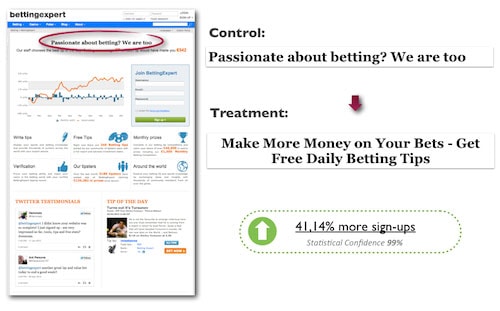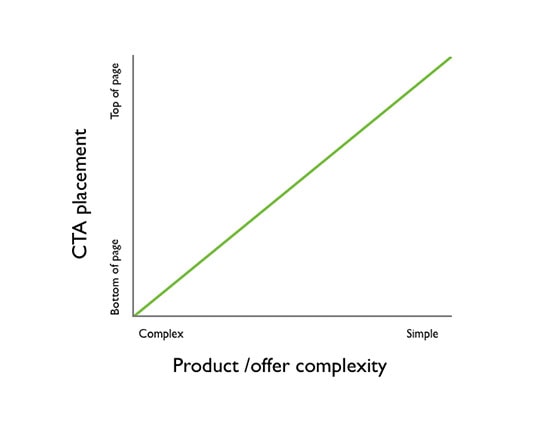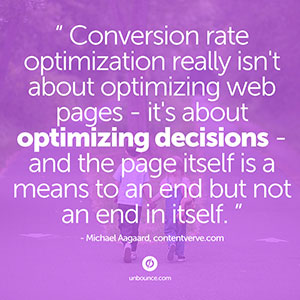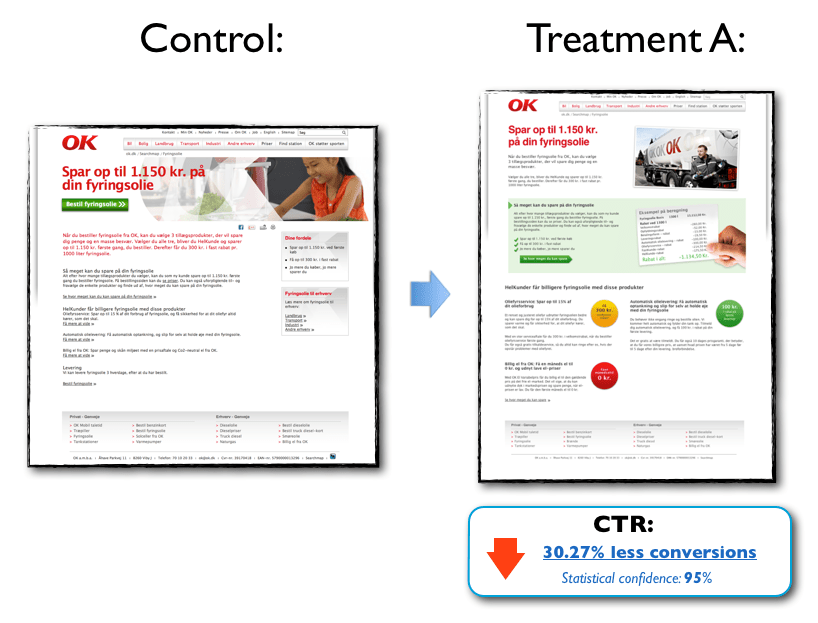- Credit goes to
Making mistakes and learning from them is an essential part of mastering the art of landing page optimization. I’ve found that out the hard way.
The good news is that there’s no reason you have to make the same mistakes that I did.
In this post, I’ll let you in on 3 basic landing page optimization mistakes that have cost me a lot of conversions. Moreover, I’ll give you simple tips that’ll help you avoid making these mistakes yourself.
If you want to create a high-converting landing page, you need to start by defining the conversion goal of your landing page. After that, you need to build a landing page treatment that revolves around your conversion goal.
If your goal is to get prospects to fill out a lead gen form, your landing page should be laser-focused on getting them to fill out that particular form. If your goal is to get potential customers to buy a product, your landing page should be laser-focused on getting them to buy that product.
I was working on an LPO project with a designer and the page we were working on was copy-heavy and very boring, so we decided to do a redesign. We were very proud of our work and felt 120% certain that our new landing page would rock – simply because we thought it looked a lot better.
Luckily, we tested the page in the real world. Because as beautiful as it may have been, the landing page treatment actually hurt conversion significantly:
Unfortunately, in all the excitement we forgot about the conversion goal and the target audience and went off on a design trip that resulted in a page that actually scared off more leads than it generated.
When your design draft is done, go over the individual elements one at a time and ask yourself, “How will this element help prospects make the right decision?”
If the answer is, “Hmm, I’m not sure – but it looks cool!” you may want to consider whether that element should even be on the landing page. As my friend Roger Dooley says:
If you want to be a successful optimizer, it’s important that the changes you make are informed solutions to real problems – and not just arbitrary guesses.
I’ve wasted precious time working on minor design details when there were much more fundamental issues that needed to be resolved. Small creative changes are fun a lot of fun to geek out on, but they rarely have direct impact on conversion if basic things like your headline are off.
Here’s an example where changing a headline increased sign-ups on a betting forum landing page by 41.14%:

In this case, the headline treatment did not come about on a whim or because I felt that it sounded awesome. This headline was created based on data on target audience insight. Moreover, the treatment is focused 100% on giving prospects a good and relevant reason to stay on the page and sign up.
Notice that the headline starts with the verb “get” – a particularly powerful word that can work wonders on your messaging. For more on the awesome conversion power of “get” check out this article.
In my experience, ideas for treatments that come about on a whim usually lead to poor results. You can of course get lucky and stumble into something that works, but in the long term it’s really not a winning strategy.
A solid optimization hypothesis goes a long way in keeping you on the right track and ensuring that you’re conducting valuable marketing experiments that will actually have an impact in the mind of the prospect –and, by extension, on conversions.
In landing page optimization, the optimization hypothesis is the basic (but data-driven) assumption that you base your optimized variant on. It encapsulates what you want to change on the landing page and what impact you expect to see from making that change. Moreover, it forces you to scrutinize your test ideas and helps you keep your eyes on the goal.
Formulating an optimization hypothesis can be as simple as filling out the blanks in this template:

Check out this article for a more in-depth guide on how to write a solid hypothesis.
However, in my experience there is no such thing as a global solution that works every time. All products, offers, landing pages, and companies are different, just like the motivations of your potential customers will be different. You need to find out what works for your specific target audience.
“So a call-to-action above the fold performed best in this LPO case study. Okay, then I should always place my CTA at the top of the page.”
As you can probably imagine, it didn’t take many landing page experiments to find out having the CTA at the top of the page isn’t always the best solution. I’ve tested lots of landing pages where a CTA placed below the fold out-performed a CTA placed above the fold.
But really it’s not a question of above or below the fold – it’s a question of placing the call-to-action where it best complements the decision-making process of your prospects.
As a general rule of thumb, if the product/offer is complex and the prospect has to digest a lot of information in order to make an informed decision, positioning the CTA lower on the page generally works best.
On the other hand, if the product/offer is very simple and the prospect hardly has to do any thinking in order to make an informed decision, positioning the CTA above the fold generally works best.
But always test, test, test to find out what works best for your campaign.

You can get a lot of inspiration and ideas from case studies but before you start implementing things, always take the time to build a solid hypothesis on how this particular test idea will increase conversion on your specific landing page.
In many cases, this simple exercise is enough to keep you from implementing things that are unlikely to work on your landing page and target audience.

Your “target audience” on the other side of the screen is made up of flesh and blood. Ultimately, their decisions and actions will determine whether your conversion rate goes up or down.
If you leave your potential customers out of the equation, your optimization efforts will never, ever reach their full potential.
What landing page optimization mistakes have you made and learned from?
Making mistakes and learning from them is an essential part of mastering the art of landing page optimization. I’ve found that out the hard way.
The good news is that there’s no reason you have to make the same mistakes that I did.
In this post, I’ll let you in on 3 basic landing page optimization mistakes that have cost me a lot of conversions. Moreover, I’ll give you simple tips that’ll help you avoid making these mistakes yourself.
1. “Optimizing” With No Clear Conversion Goal In Mind
Knowing what your goals are is essential to achieving success in any realm. Landing page optimization is no exception.If you want to create a high-converting landing page, you need to start by defining the conversion goal of your landing page. After that, you need to build a landing page treatment that revolves around your conversion goal.
If your goal is to get prospects to fill out a lead gen form, your landing page should be laser-focused on getting them to fill out that particular form. If your goal is to get potential customers to buy a product, your landing page should be laser-focused on getting them to buy that product.
How I used to get it wrong
I used to do this wrong all the time, but there’s one story in particular that comes to mind.I was working on an LPO project with a designer and the page we were working on was copy-heavy and very boring, so we decided to do a redesign. We were very proud of our work and felt 120% certain that our new landing page would rock – simply because we thought it looked a lot better.
Luckily, we tested the page in the real world. Because as beautiful as it may have been, the landing page treatment actually hurt conversion significantly:
Click image for fill size
The product in this case was heating oil, and our goal was to generate leads
for the client. Now, deciding who you are going to buy heating oil from
is a big decision for most people and a beautiful landing page is not
enough to make more people say yes.Unfortunately, in all the excitement we forgot about the conversion goal and the target audience and went off on a design trip that resulted in a page that actually scared off more leads than it generated.
A simple way to avoid this mistake
Define a clear conversion goal before you even start thinking about optimizing your landing page and keep it top of mind in every step of the optimization process.When your design draft is done, go over the individual elements one at a time and ask yourself, “How will this element help prospects make the right decision?”
If the answer is, “Hmm, I’m not sure – but it looks cool!” you may want to consider whether that element should even be on the landing page. As my friend Roger Dooley says:
“If it isn’t motivation, it’s friction.”» Tweet this «
2. Basing Optimization Decisions On Whims and Personal Preferences
In LPO, the quality of your work will ultimately be measured by the impact it has on conversion – not how beautiful it makes the page look or how sexy it makes the copy sound.If you want to be a successful optimizer, it’s important that the changes you make are informed solutions to real problems – and not just arbitrary guesses.
How I used to get it wrong
I used to base my optimization efforts on whatever felt good or seemed like a great idea in the moment. This approach gave me immediate creative satisfaction but rarely did it result in conversion lifts.I’ve wasted precious time working on minor design details when there were much more fundamental issues that needed to be resolved. Small creative changes are fun a lot of fun to geek out on, but they rarely have direct impact on conversion if basic things like your headline are off.
Here’s an example where changing a headline increased sign-ups on a betting forum landing page by 41.14%:

In this case, the headline treatment did not come about on a whim or because I felt that it sounded awesome. This headline was created based on data on target audience insight. Moreover, the treatment is focused 100% on giving prospects a good and relevant reason to stay on the page and sign up.
Notice that the headline starts with the verb “get” – a particularly powerful word that can work wonders on your messaging. For more on the awesome conversion power of “get” check out this article.
In my experience, ideas for treatments that come about on a whim usually lead to poor results. You can of course get lucky and stumble into something that works, but in the long term it’s really not a winning strategy.
A simple way to avoid this mistake
The more targeted and strategic an A/B test is, the more likely it’ll be to have a positive impact on conversions.A solid optimization hypothesis goes a long way in keeping you on the right track and ensuring that you’re conducting valuable marketing experiments that will actually have an impact in the mind of the prospect –and, by extension, on conversions.
In landing page optimization, the optimization hypothesis is the basic (but data-driven) assumption that you base your optimized variant on. It encapsulates what you want to change on the landing page and what impact you expect to see from making that change. Moreover, it forces you to scrutinize your test ideas and helps you keep your eyes on the goal.
Formulating an optimization hypothesis can be as simple as filling out the blanks in this template:

Check out this article for a more in-depth guide on how to write a solid hypothesis.
3. Assuming That “One Size Fits All”
Life would be easier if the one-size-fits-all, cookie-cutter approach worked. So much easier.However, in my experience there is no such thing as a global solution that works every time. All products, offers, landing pages, and companies are different, just like the motivations of your potential customers will be different. You need to find out what works for your specific target audience.
How I used to get it wrong
I used to think that every single case study or blog post I read was directly applicable to any given landing page.“So a call-to-action above the fold performed best in this LPO case study. Okay, then I should always place my CTA at the top of the page.”
As you can probably imagine, it didn’t take many landing page experiments to find out having the CTA at the top of the page isn’t always the best solution. I’ve tested lots of landing pages where a CTA placed below the fold out-performed a CTA placed above the fold.
But really it’s not a question of above or below the fold – it’s a question of placing the call-to-action where it best complements the decision-making process of your prospects.
As a general rule of thumb, if the product/offer is complex and the prospect has to digest a lot of information in order to make an informed decision, positioning the CTA lower on the page generally works best.
On the other hand, if the product/offer is very simple and the prospect hardly has to do any thinking in order to make an informed decision, positioning the CTA above the fold generally works best.
But always test, test, test to find out what works best for your campaign.

A simple way to avoid this mistake:
Learn what you can from other people’s results, but don’t just assume that you can simply replicate those results on your own landing page.You can get a lot of inspiration and ideas from case studies but before you start implementing things, always take the time to build a solid hypothesis on how this particular test idea will increase conversion on your specific landing page.
In many cases, this simple exercise is enough to keep you from implementing things that are unlikely to work on your landing page and target audience.
The Main Lesson I’ve Learned From All My Mistakes

Your “target audience” on the other side of the screen is made up of flesh and blood. Ultimately, their decisions and actions will determine whether your conversion rate goes up or down.
If you leave your potential customers out of the equation, your optimization efforts will never, ever reach their full potential.
What landing page optimization mistakes have you made and learned from?

0 comments:
Post a Comment